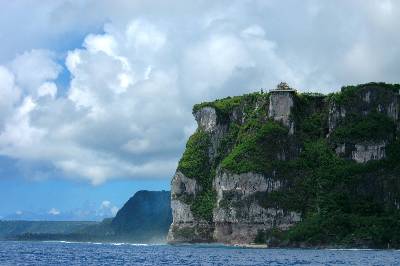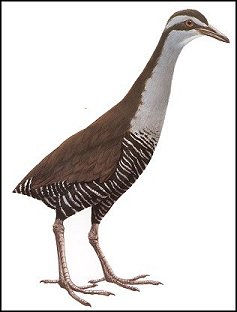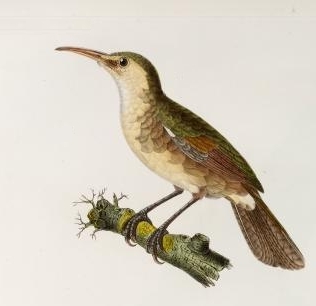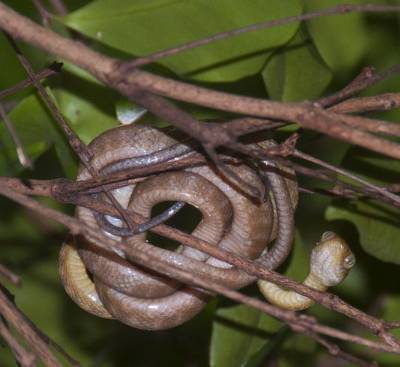Brown tree snake
Good for spiders, bad for birds
|
|
In a study to examine how the loss of forest birds is affecting Guam’s island ecosystem, biologists have found that the Pacific island’s jungles have as many as 40 times more spiders than are found on nearby islands like Saipan.
"You can’t walk through the jungles on Guam without a stick in your hand to knock down the spider webs," said Haldre Rogers, lead author of a new study this week in the open-access journal PLOS ONE.
The study examines the impact of the brown tree snake on Guam’s ecosystem. The snake, which was accidentally introduced to the island in the 1940s, has ravaged the island’s native birds in one of the most infamous ecological disasters from an invasive predator. By the 1980s, 10 of the 12 native forms of bird on Guam had been wiped out, and the last two live only in small areas protected by intense snake-trapping.
 Guam is a mecca for beach goers and scuba divers. Tourism is the island’s leading industry, but visitors rarely visit the island’s jungles where spiders are abundant.
Image: Isaac Chellman
Guam is a mecca for beach goers and scuba divers. Tourism is the island’s leading industry, but visitors rarely visit the island’s jungles where spiders are abundant.
Image: Isaac Chellman
Rogers and her colleagues are investigating to what degree the loss of birds led to an increase in the spider population on Guam, since many birds consume spiders, compete with spiders for insect prey and utilize spider webs in their nests. Small-scale experiments in other ecosystems have consistently shown a link between the presence of birds and the abundance of spiders, but the new study is the first to examine the impact of bird loss on the scale of an entire forest.
 The Guam Rail (Gallirallus owstoni) is now extinct on Guam but survives in captivity.
The Guam Rail (Gallirallus owstoni) is now extinct on Guam but survives in captivity.
Counting spider webs on Guam and on nearby islands in the Marianas Islands chain was the first step. Rogers said the difference between the number of spiders she and her colleagues counted on Guam and three nearby islands that still have birds "was far more dramatic than what any small-scale experiments had previously found." She said the findings underscore the importance of using both observed counts and controlled experiments when attempting to predict how entire ecosystems will react to change.
The 30-mile-long island of Guam is a U.S. territory, and to prevent brown tree snakes from spreading to other islands, the U.S. spends more than $1 million a year searching airplanes and cargo to prevent the snakes from escaping Guam. However, the reclusive, nocturnal reptiles are extremely hard to find. Rogers said the average resident or tourist on Guam will never see one, and even those who actively hunt them are hard-pressed to find one, which is one reason the snakes have been impossible to eradicate from the island.
Rogers’ first job on Guam was with the U.S. Geological Survey’s brown tree snake rapid response team, a small group of snake hunters charged with capturing brown tree snakes that manage to get off the island. Specifically, the team’s mission is to respond within 24 hours of any sighting of a brown tree snake on any island that is served by flights from Guam.
"When I was out there searching for snakes at night, I spent a lot of time thinking about the differences between the forests I was walking through and the forests back on Guam," Rogers said. The spider webs were just one difference. The lack of songbirds also makes Guam’s forests eerily quiet during the day, she said.
 The Guam Reed Warbler (Acrocephalus luscinius) has not been reported since the late 1960s and is presumed extinct.
The Guam Reed Warbler (Acrocephalus luscinius) has not been reported since the late 1960s and is presumed extinct.
"There isn’t any other place in the world that has lost all of its insect-eating birds," she said. "There’s no other place you can look to see what happens when birds are removed over an entire landscape."
One of the first experiments she had in mind was to investigate all those spider webs, which are much less plentiful elsewhere in the Marianas.
"I certainly wasn’t the first to notice the incredible number of spiders in the jungles on Guam, but we were the first to quantify the difference between Guam and nearby islands," Rogers said.
Historically, if ecologists wanted to study how insects reacted to the absence of birds, they would build an "exclosure," a covering designed to keep birds out of their study area. Rogers said most exclosures cover a few branches of one tree, and, in rare cases, an entire tree. Building structures large enough to exclude birds from an entire forest simply isn’t affordable, so the brown tree snake has effectively set the stage for experiments that ecologists couldn’t otherwise do.
To find out exactly how many spiders were on the island, Rogers’ team grabbed a tape measure and spent four months hiking through jungles counting spider webs, as a proxy for spiders. She and study co-authors Janneke Hille Ris Lambers and Josh Tewksbury of the University of Washington and Ross Miller of the University of Guam found that spiders were between two times and 40 times more plentiful on Guam than on neighboring islands.
Rogers said the result "shows that birds have a strong effect on spiders. Anytime you have a reduction in insectivorous birds, the system will probably respond with an increase in spiders. With insectivorous birds in decline in many places in the world, I suspect there has been a concurrent increase in spiders."
The original study is available
here.
Most shared on Macroevolution.net:
Human Origins: Are we hybrids?
On the Origins of New Forms of Life
Mammalian Hybrids
Cat-rabbit Hybrids: Fact or fiction?
Famous Biologists
Dog-cow Hybrids
Prothero: A Rebuttal
Branches of Biology
Dog-fox Hybrids
